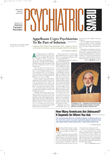Outgoing Speaker of the Assembly Albert Gaw, M.D., convened the first-ever VA Summit at APA’s 2003 annual meeting last month.
The event turned into a showcase of the accomplishments and problems of the Department of Veterans Affairs (VA) mental health services program.
Among those accomplishments is a New York Times (May 20) citation for research presented at the summit by Robert Rosenheck, M.D., about the cost-effectiveness of olanzapine.
Rosenheck, who is director of the Department of Veterans Affairs Northeast Program Evaluation Center, reported the results of the largest independent study comparing olanzapine and haloperidol. The study found no advantages for the use of olanzapine over haloperidol in terms of symptoms, Parkinsonian side effects, or quality of life.
Olanzapine was, however, associated with less akathisia and better cognitive functioning than haloperidol.
Total VA costs for olanzapine per patient per year were $3,000 to $9,000 greater than those for haloperidol.
Olanzapine’s manufacturer Eli Lilly funded the study, but it was conducted under the auspices of the VA’s cooperative studies program.
Noting that these findings differed in important respects from those of studies conducted by the manufacturer, Rosenheck said, “This study is a good example of the VA’s service to the public by conducting independent assessments of commercial products.”
(The study will be reported in full in the next issue of Psychiatric News.)
The VA’s deputy undersecretary for health policy coordination, Frances Murphy, M.D., told the group, “The VA is not only delivering excellent health care, but [the department] is getting recognized for it. We are doing a better job of measuring the results of what we do.”
She said that the next challenge for the department is to ensure continuity of care.
APA President Paul Appelbaum, M.D., said that the VA’s research on PTSD is both critically important and “world class.”
He added that the VA’s mental health services are more important than ever because resources for mental health are decreasing outside the VA.
Appelbaum expressed concern about waiting lists, demoralization of the VA staff, and the impact on academic departments of psychiatry of inadequate resources for mental health within the VA.
When Gaw opened the meeting for comments, Joel Kutnick, M.D., said, “We have terrible, terrible problems at Corpus Christi. We have 2,000 patients on a panel for one psychiatrist. We don’t even have a clerk to do administrative work. Veterans are not getting good mental health services, although the mental health team is doing the best job they can under the circumstances.”
Kutnick is a staff psychiatrist at VISN (Veterans Integrated Service Network) 17.
Incoming APA Area 4 Trustee Sidney Weissman, M.D., echoed Appelbaum’s concern about the impact of declining resources for the public mental health system.
“We must focus on heightened effectiveness. As states implode, there will be a greater drain on the VA’s mental health services,” he said.
Weissman is a program and system analyst at VISN 12 and a professor and director of psychiatric training at Northwestern University in Chicago.
Incoming Assembly Speaker Prakash Desai, M.D., said the Assembly had produced a “major document” with recommendations about treatment of the people with serious and persistent mental illness (SPMI).
“The VA and public mental health systems both carry a large burden for the care of patients with SPMI,” he said. “The Assembly’s work demonstrates an increased focus in APA on issues that are important to the entire public sector, as well as the VA.”
Desai is chief of staff at the West Side Division of the VA Chicago Healthcare System.
A psychiatrist commented that only 25 percent of the psychiatrists within the VA are members of APA. He contended that the VA inadvertently contributes to this low figure because it reimburses nonmembers $700 for attending the annual meeting and reimburses members $200, thus undercutting the advantage of the member meeting discount.
In concluding remarks, Rosenheck said, “It’s amazing what’s happened at the VA. We see twice as many patients as we did in 1995. The pain that’s been expressed here is totally valid. But, what gets done is totally remarkable.” ▪
